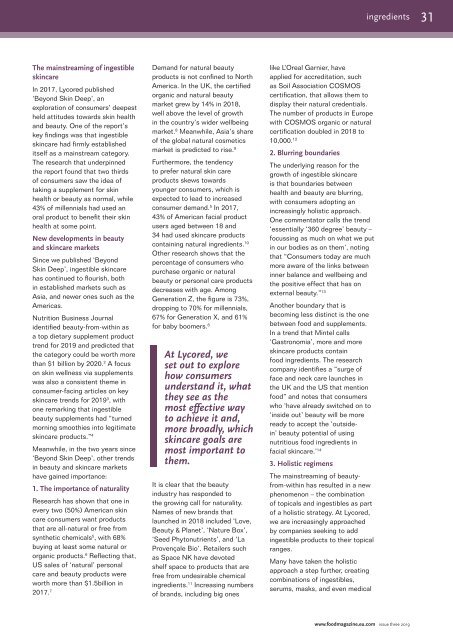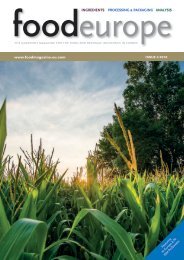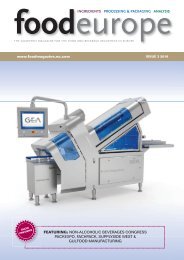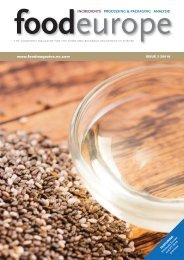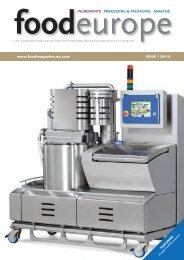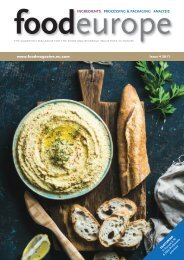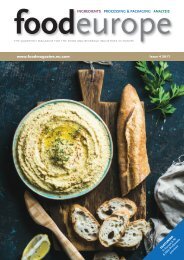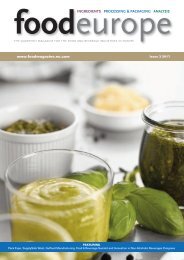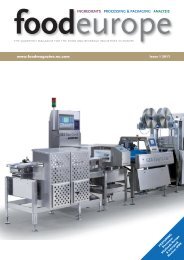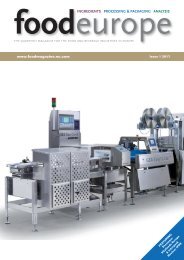Issue 3 2019
Create successful ePaper yourself
Turn your PDF publications into a flip-book with our unique Google optimized e-Paper software.
ingredients<br />
31<br />
The mainstreaming of ingestible Demand for natural beauty<br />
skincare<br />
products is not confined to North<br />
America. In the UK, the certified<br />
In 2017, Lycored published<br />
organic and natural beauty<br />
‘Beyond Skin Deep’, an<br />
market grew by 14% in 2018,<br />
exploration of consumers’ deepest<br />
well above the level of growth<br />
held attitudes towards skin health<br />
in the country’s wider wellbeing<br />
and beauty. One of the report’s<br />
market.<br />
key findings was that ingestible<br />
8 Meanwhile, Asia’s share<br />
of the global natural cosmetics<br />
skincare had firmly established<br />
market is predicted to rise.<br />
itself as a mainstream category.<br />
9<br />
The research that underpinned Furthermore, the tendency<br />
the report found that two thirds to prefer natural skin care<br />
of consumers saw the idea of products skews towards<br />
taking a supplement for skin younger consumers, which is<br />
health or beauty as normal, while expected to lead to increased<br />
43% of millennials had used an consumer demand. 5 In 2017,<br />
oral product to benefit their skin 43% of American facial product<br />
health at some point.<br />
users aged between 18 and<br />
34 had used skincare products<br />
New developments in beauty<br />
containing natural ingredients.<br />
and skincare markets<br />
10<br />
Other research shows that the<br />
Since we published ‘Beyond percentage of consumers who<br />
Skin Deep’, ingestible skincare purchase organic or natural<br />
has continued to flourish, both beauty or personal care products<br />
in established markets such as decreases with age. Among<br />
Asia, and newer ones such as the Generation Z, the figure is 73%,<br />
Americas.<br />
dropping to 70% for millennials,<br />
Nutrition Business Journal<br />
67% for Generation X, and 61%<br />
identified beauty-from-within as for baby boomers. 6<br />
a top dietary supplement product<br />
trend for <strong>2019</strong> and predicted that<br />
the category could be worth more At Lycored, we<br />
than $1 billion by 2020. 2 A focus set out to explore<br />
on skin wellness via supplements<br />
how consumers<br />
was also a consistent theme in<br />
understand it, what<br />
consumer-facing articles on key<br />
skincare trends for <strong>2019</strong> 3 , with they see as the<br />
one remarking that ingestible most effective way<br />
beauty supplements had “turned to achieve it and,<br />
morning smoothies into legitimate more broadly, which<br />
skincare products.” 4<br />
skincare goals are<br />
Meanwhile, in the two years since most important to<br />
‘Beyond Skin Deep’, other trends<br />
them.<br />
in beauty and skincare markets<br />
have gained importance:<br />
It is clear that the beauty<br />
1. The importance of naturality<br />
industry has responded to<br />
Research has shown that one in the growing call for naturality.<br />
every two (50%) American skin Names of new brands that<br />
care consumers want products launched in 2018 included ‘Love,<br />
that are all-natural or free from Beauty & Planet’, ‘Nature Box’,<br />
synthetic chemicals 5 , with 68% ‘Seed Phytonutrients’, and ‘La<br />
buying at least some natural or Provençale Bio’. Retailers such<br />
organic products. 6 Reflecting that, as Space NK have devoted<br />
US sales of ‘natural’ personal shelf space to products that are<br />
care and beauty products were free from undesirable chemical<br />
worth more than $1.5billion in ingredients. 11 Increasing numbers<br />
2017. 7 of brands, including big ones<br />
like L’Oreal Garnier, have<br />
applied for accreditation, such<br />
as Soil Association COSMOS<br />
certification, that allows them to<br />
display their natural credentials.<br />
The number of products in Europe<br />
with COSMOS organic or natural<br />
certification doubled in 2018 to<br />
10,000. 12<br />
2. Blurring boundaries<br />
The underlying reason for the<br />
growth of ingestible skincare<br />
is that boundaries between<br />
health and beauty are blurring,<br />
with consumers adopting an<br />
increasingly holistic approach.<br />
One commentator calls the trend<br />
‘essentially ‘360 degree’ beauty –<br />
focussing as much on what we put<br />
in our bodies as on them’, noting<br />
that “Consumers today are much<br />
more aware of the links between<br />
inner balance and wellbeing and<br />
the positive effect that has on<br />
external beauty.” 13<br />
Another boundary that is<br />
becoming less distinct is the one<br />
between food and supplements.<br />
In a trend that Mintel calls<br />
‘Gastronomia’, more and more<br />
skincare products contain<br />
food ingredients. The research<br />
company identifies a “surge of<br />
face and neck care launches in<br />
the UK and the US that mention<br />
food” and notes that consumers<br />
who ‘have already switched on to<br />
‘inside out’ beauty will be more<br />
ready to accept the ‘outsidein’<br />
beauty potential of using<br />
nutritious food ingredients in<br />
facial skincare.’ 14<br />
3. Holistic regimens<br />
The mainstreaming of beautyfrom-within<br />
has resulted in a new<br />
phenomenon – the combination<br />
of topicals and ingestibles as part<br />
of a holistic strategy. At Lycored,<br />
we are increasingly approached<br />
by companies seeking to add<br />
ingestible products to their topical<br />
ranges.<br />
Many have taken the holistic<br />
approach a step further, creating<br />
combinations of ingestibles,<br />
serums, masks, and even medical<br />
www.foodmagazine.eu.com issue three <strong>2019</strong>


